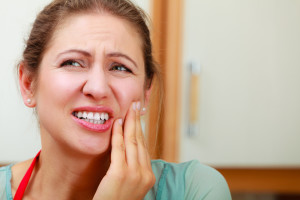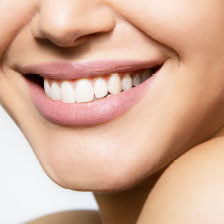 If you injured a tooth in an accident today, would you know what to do? Many people know part of how they should respond – avoid touching the root, do not dry or wash the tooth, replace it in the socket if possible. However, this is far from the only relevant information. What should you do about an injury where your tooth stays intact? How should you respond if the tooth cannot be replaced? You may need to fit a tooth with a dental crown, or acquire a prosthetic tooth. Knowing what to do after a dental emergency has occurred can help you return your oral health to good standing. (more…)
If you injured a tooth in an accident today, would you know what to do? Many people know part of how they should respond – avoid touching the root, do not dry or wash the tooth, replace it in the socket if possible. However, this is far from the only relevant information. What should you do about an injury where your tooth stays intact? How should you respond if the tooth cannot be replaced? You may need to fit a tooth with a dental crown, or acquire a prosthetic tooth. Knowing what to do after a dental emergency has occurred can help you return your oral health to good standing. (more…)
Is A Whitening Treatment Right For Your Teeth?
 Tooth discoloration can come in extrinsic form, or intrinsic form. Typically, when people think about what can affect the color of their teeth, they think about extrinsic stains. These are the stains in your enamel that can come from certain foods and beverages, as well as from using tobacco products. However, other people suffer from intrinsic discoloration, or discoloration that resides in deeper layers than the extrinsic stains. These issues can result from physical trauma, or from taking certain medications. Teeth whitening treatments eliminate extrinsic stains, but can be less effective when discoloration is intrinsic. Your dentist can examine your teeth and help you know if conventional whitening will serve your needs. (more…)
Tooth discoloration can come in extrinsic form, or intrinsic form. Typically, when people think about what can affect the color of their teeth, they think about extrinsic stains. These are the stains in your enamel that can come from certain foods and beverages, as well as from using tobacco products. However, other people suffer from intrinsic discoloration, or discoloration that resides in deeper layers than the extrinsic stains. These issues can result from physical trauma, or from taking certain medications. Teeth whitening treatments eliminate extrinsic stains, but can be less effective when discoloration is intrinsic. Your dentist can examine your teeth and help you know if conventional whitening will serve your needs. (more…)
The Relationship Between Tooth Loss And TMJ Problems
 TMJ is a common abbreviation for your temporomandibular joint – these are the joints that connect your jaw to your skull. Your jaw function is controlled by the trigeminal nerve, which is also responsible for processing sensations of your face and head. When you develop TMJ problems, the nerve can become aggravated, and you can experience facial soreness, and headaches. TMJ problems also make it more difficult to properly move your jaw. While many events can lead to trouble with your TMJs, having lost teeth puts you at greater risk. (more…)
TMJ is a common abbreviation for your temporomandibular joint – these are the joints that connect your jaw to your skull. Your jaw function is controlled by the trigeminal nerve, which is also responsible for processing sensations of your face and head. When you develop TMJ problems, the nerve can become aggravated, and you can experience facial soreness, and headaches. TMJ problems also make it more difficult to properly move your jaw. While many events can lead to trouble with your TMJs, having lost teeth puts you at greater risk. (more…)
Planning A Full-Mouth Rehabilitation
 If you have simultaneous issues with several teeth, one treatment may not be the solution for all of your dental needs. Full-mouth rehabilitation is a course of treatments that aims to bring your oral health to good standing. It can be a combination of restorative work, cosmetic procedures, and prosthetic dentistry. Essentially, it is a long-term plan set by you and your dentist, where the end result is a healthy, good-looking smile you can show the world. It can also incorporate the treatment of painful conditions, like TMJ dysfunction. (more…)
If you have simultaneous issues with several teeth, one treatment may not be the solution for all of your dental needs. Full-mouth rehabilitation is a course of treatments that aims to bring your oral health to good standing. It can be a combination of restorative work, cosmetic procedures, and prosthetic dentistry. Essentially, it is a long-term plan set by you and your dentist, where the end result is a healthy, good-looking smile you can show the world. It can also incorporate the treatment of painful conditions, like TMJ dysfunction. (more…)
Addressing Gaps Between Your Teeth
 If you are self-conscious about the presence of a gap between teeth in your smile, remedies are available. Whether the gap is caused by an uneven row of teeth, an abnormally small tooth, or some other condition, you can work with your dentist to have it covered up. Because multiple approaches, like dental bonding, exist for treating this problem, you can talk to your dentist about the procedure that best addresses your needs. Some cosmetic remedies can take longer, or be more involved, but they may offer additional benefits. (more…)
If you are self-conscious about the presence of a gap between teeth in your smile, remedies are available. Whether the gap is caused by an uneven row of teeth, an abnormally small tooth, or some other condition, you can work with your dentist to have it covered up. Because multiple approaches, like dental bonding, exist for treating this problem, you can talk to your dentist about the procedure that best addresses your needs. Some cosmetic remedies can take longer, or be more involved, but they may offer additional benefits. (more…)
How To Preserve The Look Of Your Porcelain Veneers
 Porcelain veneers can hide flaws in the shape and condition of your teeth, and give you an attractive new smile. Veneers are bonded to your teeth, and offer a long-term solution to a range of cosmetic anxieties. However, because they are a permanent addition, you will need to take caution to ensure that you maintain the quality of their appearance. Veneers are designed to be durable, and resistant to things like stains, or damages, but they are not invincible. If you receive veneers, you should be prepared to take steps that preserve their attractiveness over time. (more…)
Porcelain veneers can hide flaws in the shape and condition of your teeth, and give you an attractive new smile. Veneers are bonded to your teeth, and offer a long-term solution to a range of cosmetic anxieties. However, because they are a permanent addition, you will need to take caution to ensure that you maintain the quality of their appearance. Veneers are designed to be durable, and resistant to things like stains, or damages, but they are not invincible. If you receive veneers, you should be prepared to take steps that preserve their attractiveness over time. (more…)
Unaddressed Tooth Loss Can Complicate Your Oral Health
 Just one lost tooth is all it takes to compromise everyday habits like eating and speaking. If you are missing a tooth, it can force you to adjust how you chew your food. It may also cause you to be self-conscious and try to avoid exposing the absence when you speak or smile. An absence can also have negative affects on your jawbone, and robs neighboring teeth of support. Prosthetic dentistry offers several ways for your dentist to restore your complete smile. A dental bridge can close a gap in your teeth. To remedy the loss of the tooth root, you can receive a dental implant to support your prosthetic. (more…)
Just one lost tooth is all it takes to compromise everyday habits like eating and speaking. If you are missing a tooth, it can force you to adjust how you chew your food. It may also cause you to be self-conscious and try to avoid exposing the absence when you speak or smile. An absence can also have negative affects on your jawbone, and robs neighboring teeth of support. Prosthetic dentistry offers several ways for your dentist to restore your complete smile. A dental bridge can close a gap in your teeth. To remedy the loss of the tooth root, you can receive a dental implant to support your prosthetic. (more…)
Working With Your Dentist To Address TMJ Dysfunction
 TMJ refers to the temporomandibular joint, the joints that connect your jawbone to the rest of your skull. Problems with your TMJs can result in a number of uncomfortable symptoms. TMJ dysfunction can cause headaches, make it difficult to move your jaw to speak or eat, and can even cause your jaw to feel “stuck,” and become difficult to move. Your dentist can work with you to identify potential causes of TMJ dysfunction, and help you address its related aches and pains. (more…)
TMJ refers to the temporomandibular joint, the joints that connect your jawbone to the rest of your skull. Problems with your TMJs can result in a number of uncomfortable symptoms. TMJ dysfunction can cause headaches, make it difficult to move your jaw to speak or eat, and can even cause your jaw to feel “stuck,” and become difficult to move. Your dentist can work with you to identify potential causes of TMJ dysfunction, and help you address its related aches and pains. (more…)
Crooked Teeth And Cavities
 Crooked teeth can adversely affect the appearance of your smile, but their effect is not just cosmetic. They can leave certain parts of your teeth less accessible when you brush, which makes those hard-to-reach areas more susceptible to developing cavities. If your teeth are misaligned, but you are apprehensive about receiving braces, you could benefit from Invisalign aligners. Invisalign can straighten teeth without visually obtrusive bracket-and-wire braces. In addition to improving your appearance, aligners can eliminate the awkward overlaps between teeth that face an increased risk for cavities. (more…)
Crooked teeth can adversely affect the appearance of your smile, but their effect is not just cosmetic. They can leave certain parts of your teeth less accessible when you brush, which makes those hard-to-reach areas more susceptible to developing cavities. If your teeth are misaligned, but you are apprehensive about receiving braces, you could benefit from Invisalign aligners. Invisalign can straighten teeth without visually obtrusive bracket-and-wire braces. In addition to improving your appearance, aligners can eliminate the awkward overlaps between teeth that face an increased risk for cavities. (more…)
Responding To Different Types Of Tooth Discoloration
 Whitening treatments are intended to treat stains that have discolored your enamel. Over-the-counter treatments address surface stains, while the whitening treatments from your dentist can treat stains that are deeper-set in your enamel. But what about discoloration that comes from something other than enamel stains? Standard whitening may be less well-suited to treat discoloration that comes from physical trauma, or from taking certain medications. Your dentist can help you determine if traditional whitening methods are right for you. If you are not an ideal candidate for this treatment, other cosmetic treatments are available to help you attain the smile you want to show the world.
Whitening treatments are intended to treat stains that have discolored your enamel. Over-the-counter treatments address surface stains, while the whitening treatments from your dentist can treat stains that are deeper-set in your enamel. But what about discoloration that comes from something other than enamel stains? Standard whitening may be less well-suited to treat discoloration that comes from physical trauma, or from taking certain medications. Your dentist can help you determine if traditional whitening methods are right for you. If you are not an ideal candidate for this treatment, other cosmetic treatments are available to help you attain the smile you want to show the world.
Teeth Whitening From Your Dentist
Your dentist can offer a whitening treatment in-office, or provide the necessary tools for you to whiten your teeth at home. For at-home treatment, you will receive custom-fit trays to ensure that the provided whitening agent is evenly applied to your teeth. Daily application of the whitening treatment should provide you with desired results in approximately two weeks. In-office treatment can typically be done in a single visit. Unlike over-the-counter whitening solutions, the treatment from your dentist uses bleaching compounds to affect stains that have settled into your enamel, not just discoloration on the surface of your teeth.
Cosmetic Treatments To Whiten Teeth
If your teeth are less responsive to whitening, other techniques are available. You can have porcelain veneers permanently attached to the front of your teeth. The veneers can present the appearance of vividly white teeth, and also hide any other problems with your natural teeth. Your dentist can perform dental bonding on a tooth that has become discolored due to damage. The resin used for bonding can have its tint adjusted to match your teeth.







